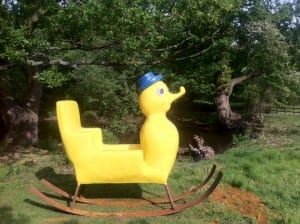My interest in physical humour, mime and puppetry has lead me to various artists that have become very popular on the British comedy circuit for their unique style. One in particular that has inspired me in my research and development is The Boy With Tape On His Face who uses random objects and a musical score to create a fresh and innovative way to puppeteer. The magic does not only come from his skills as a puppeteer and a performer but the inventiveness of his material and the intelligent use of song. The songs are all well known and creates an instant atmosphere for each little sketch (which you can see from the extract) as they are from popular culture and are easily recognizable.
The key thing that I have noticed to his approach is his use of focus and attention. His focus is constantly on the object to help give focus and allow the audience to project a character onto it, the music also helps with this. Once that is established his eyes can wander away from the puppet as the audiences are shown the relationship between him and the puppet, with all the other gaps being filled by the music and the audiences imagination. The humour comes from the absurd and creative narratives that he creates and the novelty music that accompanies it. Who would have ever thought oven gloves could be so entertaining!
The beginning of this other extract also highlights the skill and precise movement needed to bring the objects and scenarios to life. His sense of timing is impeccable and the subtlety of his actions create a fictional relationship with an inanimate object. When I watched his show at the Edinburgh fringe in 2011 I found I was laughing at myself for believing his illusions.
One show that has always been inspirational to me was The Adventures of Alvin Sputnik: Deep Sea Explorer, which combines unique hand puppetry and a vibrant use of multi- media, which creates beautiful storytelling. The underwater world Is imagined through lighting, projections and animations which alters the space as Alvin has various puppet sizes to emphasise the magnitude of his journey.
I am still to this day astonished by how emotive the show was when all he had was three various sized puppets of Alvin and projections. I feel that the key to it was the story, which was established well at the beginning with an animated video. The introduction, much like The Boy With Tape On His Face, establishes the character and scenario so that the audience fills in the gaps with their imagination.
For me, these examples have inspired me to work with visuals, mime and puppetry in order to create a fun, surreal and possibly comical piece of performance. I have various images in my head that I am looking to attempt to re-create through the research and development phases. One of these ideas is to portray when I was 16 I had a nightmare that I was going to work in an office. I am looking to create the atmosphere of the absurd through sock/ hand puppets, music and lighting to create a sense of distortion. I am keeping open minded and tomorrow I will be experimenting on a number of puppetry, mime and physical theatre techniques to find which one best suits my abilities and the performance I wish to create.
My next blog will be the results of my preliminary performance research.
